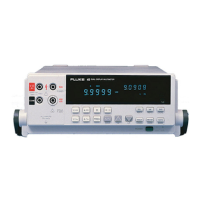45
Service Manual
4-20
Note that the 300 kΩ and 3 MΩ ranges are quite sensitive to noise. Any movement
of the input leads or movement of the hands or body in the vicinity of the leads can
cause noisy readings. Use shielded leads during this calibration. Verify these two
calibration points for accuracy at the conclusion of the calibration procedure.
2. Complete steps 25 through 29 in Table 4-7. Then clear the ohms source.
4-28. Continuity/Hysteresis Threshold Calibration (Computer Interface)
1. Connect the DC Volts Calibrator to the Fluke 45
X and COM inputs. Then
send:
CAL 8
2. Complete steps 30 and 31 in Table 4-7, and clear the source.
4-29. Frequency Calibration (Computer Interface)
1. Connect the Frequency Calibrator to the Fluke 45 X and COM inputs. Then
send:
CAL 9
2. Complete step 32 in Table 4-7. Then clear the frequency source.
4-30. Concluding Calibration Using the Computer Interface
At the conclusion of this type of calibration, first make sure the source is cleared. Then
press the Cal Enable button on the meter to exit calibration mode.
Calibration mode can also be exited at any time by sending the *RST command. If this
command is sent prior to completion of all calibration points for the selected function, no
changes are made to nonvolatile calibration memory for that function.
If calibration mode is exited after completion of calibration of any function except VDC,
constants for other functions are not affected. But remember, whenever VDC is
calibrated, the calibration procedure for all other functions should be performed.
4-31. Alternate Ohms Calibration (Computer Interface)
This procedure can be used with discrete resistor values (such as a decade box). On the
300 Ω range, this alternate procedure uses a 290 Ω source and yields a specification of
0.05%+2 digits +0.02 Ω. Alternate calibration of this range is detailed below, although
discrete resistor values can be used for all ranges. Lead and source zero resistances are
only taken into account for the lowest two ranges (300 Ω and 3 kΩ).
1. Add the value of lead and source zero resistance to the certified value of the source
resistor. Lead and source zero resistance is the value obtained with the VAL?
command, immediately prior to entering dc volts calibration. Use this total value as
’xxx.xx’ in the following command:
CALREF xxx.xx
2. Now send
CALSTEP?
Table 4-8. Calibration Mode Computer Interface Commands

